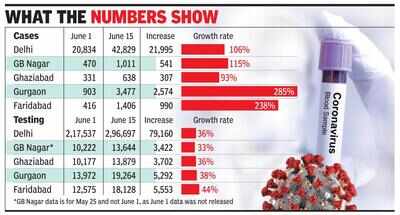
Covid cases have seen a significant spurt across the National Capital Region in the past 15 days, when restrictions on movement have eased and industries have started to open.
While cases in Gurgaon shot from 903 to 3,477 in the first 15 days of this month, Noida, which just had 470 cases on June 1, reported 1,011 cases by June 15 and became the district with the highest Covid numbers in UP. During this period, Delhi has seen the worst of the outbreak — reporting more than 21,000 cases.
But despite the rise in cases, testing has not grown in the same proportion. Among the big five in Delhi-NCR (Delhi, Gurgaon, Noida, Ghaziabad and Faridabad), Faridabad has registered the highest rate of increase in testing between June 1 and 15. The Haryana district is testing close to 400 samples a day (in absolute numbers, Delhi is far higher than all others). Gurgaon, however, has tested over 1,000 more samples than Faridabad and almost 6,000 samples more than Noida.
In comparison, Noida’s average has been 244. As of June 15, Noida had collected the least samples for testing among the big five. Ghaziabad, which has been organising health camps to test vulnerable sections, had collected more samples than Noida. The testing growth rate for Noida was also the least among the five cities in the June 1-15 period.
Noida has recorded 303 Covid cases in the last week alone. Officials said the rise in numbers was expected with the easing of restrictions. “This was expected as people started coming out for work and interactions grew. We have to restrict the spread of the virus in sensitive areas. This is why it’s important that we remain vigilant in the containment zones. Regular commute to and from Delhi is also a major concern as the infection is widespread there,” said a senior health department official in Noida. Both Noida and Ghaziabad have sealed their borders with Delhi. Police are allowing only those who have valid IDs and passes.
Between June 1 and 15, Ghaziabad has added 307 cases. But unlike Noida, the rate of increase in cases has slowed down in Ghaziabad of late. The daily average rate in Ghaziabad was 3.2% on May 31, which rose steadily to reach 6.3% on June 10. Since then, it has been declining steadily — touching 3.8% on June 16. This decreasing growth trend has also slowed the doubling rate of cases from 11 on June 9 to 19 on June 16.
In Noida, despite the steady rise in Covid cases, the death rate is the lowest in UP. Till June 15, Agra had reported 66 deaths, Kanpur 27, Meerut 60 and Ghaziabad 25. Noida saw 12 Covid deaths during this time.
Officials in Noida, however, were cautious. “We do have good facilities here and fewer deaths compared to those in the top five districts of UP. However, we have been getting serious cases and we need to be cautious about that. That is why contract tracing is of utmost importance now,” an official said.
“Covid patients have to be kept away from the public and their immediate contacts have to be traced. Just a month and a half ago, we would hear about the threat from super-spreaders. How many such spreaders are among us is not known. Fatigue is setting in among the frontline workers and it is going to be a challenge to motivate them,” said Ashok Mishra, a retired chief medical officer. He also emphasised that irrespective of the population, every district in NCR needs to focus on testing to detect Covid early.
While cases in Gurgaon shot from 903 to 3,477 in the first 15 days of this month, Noida, which just had 470 cases on June 1, reported 1,011 cases by June 15 and became the district with the highest Covid numbers in UP. During this period, Delhi has seen the worst of the outbreak — reporting more than 21,000 cases.
But despite the rise in cases, testing has not grown in the same proportion. Among the big five in Delhi-NCR (Delhi, Gurgaon, Noida, Ghaziabad and Faridabad), Faridabad has registered the highest rate of increase in testing between June 1 and 15. The Haryana district is testing close to 400 samples a day (in absolute numbers, Delhi is far higher than all others). Gurgaon, however, has tested over 1,000 more samples than Faridabad and almost 6,000 samples more than Noida.
In comparison, Noida’s average has been 244. As of June 15, Noida had collected the least samples for testing among the big five. Ghaziabad, which has been organising health camps to test vulnerable sections, had collected more samples than Noida. The testing growth rate for Noida was also the least among the five cities in the June 1-15 period.
Noida has recorded 303 Covid cases in the last week alone. Officials said the rise in numbers was expected with the easing of restrictions. “This was expected as people started coming out for work and interactions grew. We have to restrict the spread of the virus in sensitive areas. This is why it’s important that we remain vigilant in the containment zones. Regular commute to and from Delhi is also a major concern as the infection is widespread there,” said a senior health department official in Noida. Both Noida and Ghaziabad have sealed their borders with Delhi. Police are allowing only those who have valid IDs and passes.
Between June 1 and 15, Ghaziabad has added 307 cases. But unlike Noida, the rate of increase in cases has slowed down in Ghaziabad of late. The daily average rate in Ghaziabad was 3.2% on May 31, which rose steadily to reach 6.3% on June 10. Since then, it has been declining steadily — touching 3.8% on June 16. This decreasing growth trend has also slowed the doubling rate of cases from 11 on June 9 to 19 on June 16.
In Noida, despite the steady rise in Covid cases, the death rate is the lowest in UP. Till June 15, Agra had reported 66 deaths, Kanpur 27, Meerut 60 and Ghaziabad 25. Noida saw 12 Covid deaths during this time.
Officials in Noida, however, were cautious. “We do have good facilities here and fewer deaths compared to those in the top five districts of UP. However, we have been getting serious cases and we need to be cautious about that. That is why contract tracing is of utmost importance now,” an official said.
“Covid patients have to be kept away from the public and their immediate contacts have to be traced. Just a month and a half ago, we would hear about the threat from super-spreaders. How many such spreaders are among us is not known. Fatigue is setting in among the frontline workers and it is going to be a challenge to motivate them,” said Ashok Mishra, a retired chief medical officer. He also emphasised that irrespective of the population, every district in NCR needs to focus on testing to detect Covid early.
Quick Links
Kerala Coronavirus Helpline NumberHaryana Coronavirus Helpline NumberUP Coronavirus Helpline NumberBareilly NewsBhopal NewsCoronavirus in DelhiCoronavirus in HyderabadCoronavirus in IndiaCoronavirus symptomsCoronavirusRajasthan Coronavirus Helpline NumberAditya ThackerayShiv SenaFire in MumbaiAP Coronavirus Helpline NumberArvind KejriwalJammu Kashmir Coronavirus Helpline NumberSrinagar encounter
Get the app








